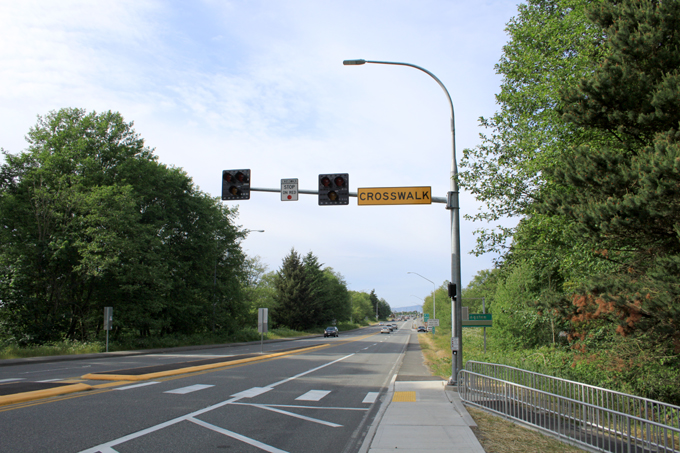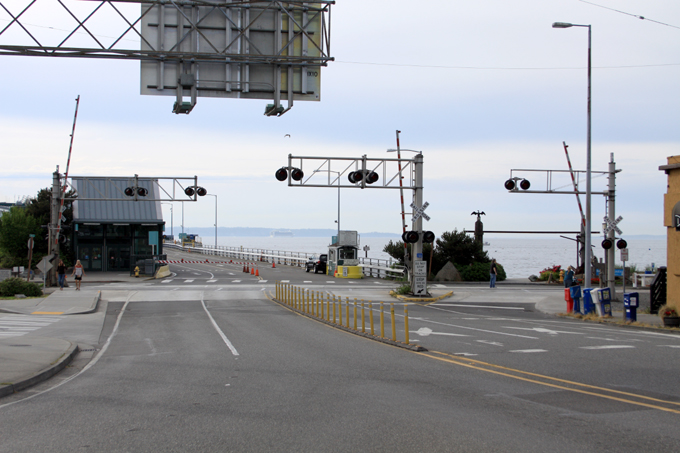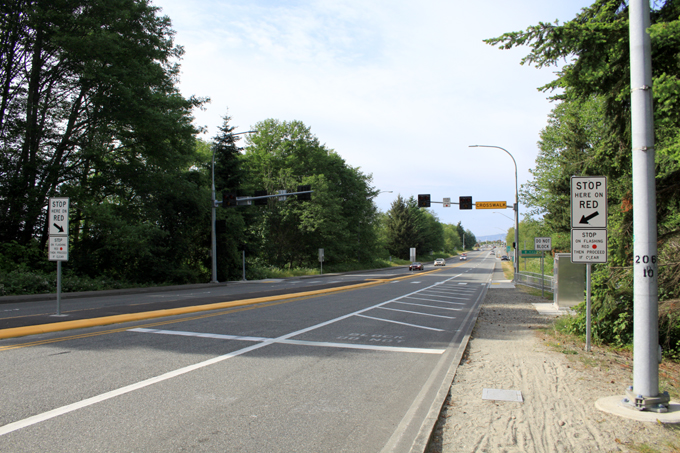A newer form of pedestrian crossing signal is the HAWK beacon signal, which overall is a compromise between a flashing yellow beacon and a standard traffic signal. With slowly increasing use in the Seattle area, there are some advantages and disadvantages to them.
Overview
First introduced in Arizona in 2000 and officially named “Pedestrian-Hybrid Beacons” by the Federal Highway Administration, HAWK (High-Intensity Activated Crosswalk) beacons are intended for use at pedestrian crossings where pedestrian or vehicle traffic is considered too high for a flashing yellow beacon, and too low for a standard traffic signal.
The beacon itself consists of two red lights positioned horizontally, with a single yellow light underneath. The pedestrian signals are standard ones used at pedestrian crossings.
The main trait differentiating it from standard traffic signals or lights at pedestrian crossings is the use of two red lights per beacon, which is explained to be more attention-receiving than more standard signals.
Two solid red lights stop vehicles and permit pedestrians to cross, and two alternating flashing red lights allow vehicles to proceed after stopping when the crosswalk is clear. Signs at and near the crossing tell drivers the meaning of the red lights.
Since they are technically considered to be traffic beacons and not traffic signals, they are off when not in use. The accompanying pedestrian signals remain on.
From WSDOT – YouTube
The signal phasing is illustrated here, and is also described here differently as follows:
- [Inactive]: The vehicle beacon is off; the pedestrian signal is red (don’t walk)
- [Pedestrian pushes walk button]: The vehicle beacon flashes yellow; the pedestrian signal is red
- [Pedestrian waits]: The vehicle beacon is yellow; the pedestrian signal is red
- [Pedestrian crosses]: The vehicle beacon is dual red; the pedestrian signal is white (walk)
- [Pedestrian finishes crossing]: The vehicle beacon is alternating flashing red; the pedestrian signal flashes red
- [Inactive]: The vehicle beacon is off; the pedestrian signal is red
There are at least four HAWK signals currently operating in the Seattle area, with a few more in planning:
- South Machias Road at Centennial Middle School, Snohomish (opened March 3, 2015)
- Puget Park Drive at Mill Creek YMCA, Mill Creek (opened 2010)
- Edmonds Way (SR 104) at City Park, Edmonds (opened February 4, 2015)
- 148th Avenue NE & NE 87th Street, Redmond (opened May 1, 2015)
The specific one shown here is the HAWK crossing on Edmonds Way, which is also the only one on a state highway in the region.
The alternating flashing red light phase
The traffic beacon flashes red on alternating lights when the pedestrian signal is flashing red. Unlike in regular traffic signal-controlled crosswalks, this allows for cars to pass through after stopping if the crosswalk is clear, improving the efficiency of the intersection.
However, the alternating flashing red lights on HAWK beacons appear similar to ones on railway crossing lights. This leads to the inconsistency where at a HAWK beacon drivers stop and can proceed when clear, but at a railway crossing drivers stop and must remain there until the lights turn off.
For example, in Edmonds two railway crossings are located north of the HAWK crossing. Many drivers traveling through the area would encounter two sets of alternating flashing red lights with very different meanings, and can potentially be a safety issue at the railway crossings.
There are cases where drivers remain stopped at a HAWK beacon during the alternating flashing red phase, even though they can proceed if no one is in the crosswalk.
The off phase
A typical traffic signal with 3-5 lights has at least one light on or flashing when in normal service. The HAWK beacon has 3 lights and has no lights on when not being used.
This leads to the inconsistency where a traffic signal with no lights on is assumed to be a power failure and treated as a stop sign, but a HAWK beacon with no lights on is not treated as such.
Since the related pedestrian signal remains red, meaning pedestrians are not supposed to cross the street, the off phase for drivers functions the same as a green light phase, but no indication is given to drivers.
An alternative
While HAWK beacons have their advantages, their potential issues can lead to agencies avoiding them. An alternative is a regular traffic signal with a flashing red signal for drivers during a flashing “don’t walk” signal for pedestrians, occurring after a solid red signal for drivers during a “walk” signal for pedestrians.
This functions like the HAWK beacon’s alternating flashing red signal, but with a more standardized format. The signal also always has a light present to inform drivers, by having a green light. This should be easier to understand than a HAWK beacon which can need extra signs.
One issue is that one flashing red light could be less attention-receiving than two alternating flashing red lights, which is one argument for HAWK beacons, though it could be more attention-receiving particularly when farther away from the crosswalk.
Southern California has an example with a flashing yellow signal instead of a solid green signal, and another example with only a flashing red signal and no solid red signal.
Alternatively, a regular traffic signal would be a more standard solution instead of a HAWK beacon. While it is less efficient for vehicle throughput, it would provide additional safety for pedestrians.
External Links & References:
- HAWK Beacon – Wikipedia
- HAWK Pedestrian-Friendly Beacon – Snohomish County
- S Machias at Centennial Middle School – Snohomish County
- How to navigate a High-intensity Activated crossWalK (HAWK) signal – Washington State Department of Transportation [PDF]
- WSDOT explains new Highway 104 crosswalk; activation tentatively set for Feb. 4 – January 29, 2015 – My Edmonds News
-
New signalized crosswalk set to open on SR 104 in Edmonds – February 2, 2015 – Washington State Department of Transportation
- It’s official: The new SR 104 crosswalk now open – February 4, 2015 – My Edmonds NewsCentennial Middle School gets sophisticated crosswalk signal – March 3, 2015 – The Everett Herald
- Redmond Traffic – May 1, 2015 – Twitter
Updated June 3, 2015



Recent Comments